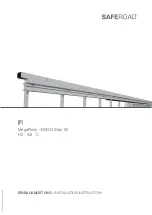Summary of Contents for Citation Bravo
Page 4: ...1 2 Developed for Training Purposes Citation Bravo March 2009 CAE SimuFlite ...
Page 6: ...1 4 Developed for Training Purposes Citation Bravo March 2009 CAE SimuFlite ...
Page 8: ...2 2 Developed for Training Purposes Citation Bravo September 2005 CAE SimuFlite ...
Page 52: ...2 46 Developed for Training Purposes Citation Bravo September 2005 CAE SimuFlite ...
Page 60: ...2 54 Developed for Training Purposes Citation Bravo September 2005 CAE SimuFlite ...
Page 62: ...3 2 Developed for Training Purposes Citation Bravo September 2005 CAE SimuFlite ...
Page 64: ...3A 2 Developed for Training Purposes Citation Bravo September 2005 CAE SimuFlite ...
Page 66: ...3A 4 Developed for Training Purposes Citation Bravo September 2005 CAE SimuFlite ...
Page 72: ...3A 10 Developed for Training Purposes Citation Bravo September 2005 CAE SimuFlite ...
Page 74: ...3A 12 Developed for Training Purposes Citation Bravo September 2005 CAE SimuFlite ...
Page 78: ...3A 16 Developed for Training Purposes Citation Bravo March 2009 CAE SimuFlite 9 8 6 7A 7B ...
Page 80: ...3A 18 Developed for Training Purposes Citation Bravo July 2004 CAE SimuFlite 1 2 3 4 6 5 ...
Page 82: ...3A 20 Developed for Training Purposes Citation Bravo March 2009 CAE SimuFlite 7 8 9 10 11 ...
Page 84: ...3A 22 Developed for Training Purposes Citation Bravo March 2009 CAE SimuFlite 1 2 3 5 6 7 4 ...
Page 90: ...3A 28 Developed for Training Purposes Citation Bravo July 2004 CAE SimuFlite 1 2 3 4 5 6 ...
Page 92: ...3A 30 Developed for Training Purposes Citation Bravo July 2004 CAE SimuFlite 1 2 3 4 5 6 7 ...
Page 94: ...3A 32 Developed for Training Purposes Citation Bravo July 2004 CAE SimuFlite 1 2A 2B 3 4 5 6 ...
Page 96: ...3A 34 Developed for Training Purposes Citation Bravo July 2004 CAE SimuFlite 1 2 3 4 5 6 ...
Page 104: ...3A 42 Developed for Training Purposes Citation Bravo July 2004 CAE SimuFlite ...
Page 108: ...3A 46 Developed for Training Purposes Citation Bravo July 2004 CAE SimuFlite ...
Page 110: ...CAE SimuFlite 3B 2 Developed for Training Purposes Citation Bravo September 2005 ...
Page 140: ...CAE SimuFlite 3B 32 Developed for Training Purposes Citation Bravo September 2005 ...
Page 142: ...CAE SimuFlite 3B 34 Developed for Training Purposes Citation Bravo September 2005 ...
Page 164: ...CAE SimuFlite 3C 2 Developed for Training Purposes Citation Bravo September 2005 ...
Page 194: ...CAE SimuFlite 3C 32 Developed for Training Purposes Citation Bravo March 2009 ...
Page 196: ...3D 2 For Training Purposes Only Citation Bravo October 2013 ...
Page 200: ...3D 6 For Training Purposes Only Citation Bravo October 2013 ...
Page 218: ...3D 24 For Training Purposes Only Citation Bravo October 2013 ...
Page 222: ...Citation Bravo For Training Purposes Only 3D 28 October 2013 ...
Page 225: ...Maneuvers Citation Bravo For Training Purposes Only 3D 31 October 2013 Rejected Takeoff ...
Page 226: ...Maneuvers 3D 32 For Training Purposes Only Citation Bravo October 2013 Rejected Takeoff 3D 31 ...
Page 229: ...Maneuvers Citation Bravo For Training Purposes Only 3D 35 October 2013 Steep Turns ...
Page 230: ...Maneuvers 3D 36 For Training Purposes Only Citation Bravo October 2013 Steep Turns 3D 35 ...
Page 232: ...Maneuvers 3D 38 For Training Purposes Only Citation Bravo October 2013 3D 37 ...
Page 234: ...Maneuvers 3D 40 For Training Purposes Only Citation Bravo October 2013 3D 39 ...
Page 247: ...Maneuvers Citation Bravo For Training Purposes Only 3D 53 October 2013 Circling Approach ...
Page 254: ...4 2 Developed for Training Purposes Citation Bravo September 2005 CAE SimuFlite ...
Page 258: ...4 6 Developed for Training Purposes Citation Bravo September 2005 CAE SimuFlite ...
Page 260: ...4 8 Developed for Training Purposes Citation Bravo September 2005 CAE SimuFlite ...
Page 262: ...4 10 Developed for Training Purposes Citation Bravo September 2005 CAE SimuFlite ...
Page 284: ...4 32 Developed for Training Purposes Citation Bravo September 2005 CAE SimuFlite ...
Page 312: ...4 60 Developed for Training Purposes Citation Bravo September 2005 CAE SimuFlite ...
Page 338: ...4 86 Developed for Training Purposes Citation Bravo September 2005 CAE SimuFlite ...
Page 348: ...4 96 Developed for Training Purposes Citation Bravo September 2005 CAE SimuFlite ...
Page 352: ...5A 2 Developed for Training Purposes Citation Bravo July 2004 CAE SimuFlite ...
Page 368: ...5A 18 Developed for Training Purposes Citation Bravo July 2004 CAE SimuFlite ...
Page 370: ...5A 20 Developed for Training Purposes Citation Bravo July 2004 CAE SimuFlite ...
Page 372: ...5A 22 Developed for Training Purposes Citation Bravo July 2004 CAE SimuFlite ...
Page 374: ...5A 24 Developed for Training Purposes Citation Bravo July 2004 CAE SimuFlite ...
Page 376: ...5B 2 Developed for Training Purposes Citation Bravo Septmember 2005 CAE SimuFlite ...
Page 424: ...5B 50 Developed for Training Purposes Citation Bravo September 2005 CAE SimuFlite ...
Page 458: ...5B 84 Developed for Training Purposes Citation Bravo September 2005 CAE SimuFlite ...
Page 466: ...5B 92 Developed for Training Purposes Citation Bravo September 2005 CAE SimuFlite ...
Page 468: ...5C 2 Developed for Training Purposes Citation Bravo September 2005 CAE SimuFlite ...
Page 508: ...5C 42 Developed for Training Purposes Citation Bravo September 2005 CAE SimuFlite ...
Page 510: ...5D 2 Developed for Training Purposes Citation Bravo September 2005 CAE SimuFlite ...
Page 518: ...5D 10 Developed for Training Purposes Citation Bravo September 2005 CAE SimuFlite ...
Page 522: ...5D 14 Developed for Training Purposes Citation Bravo September 2005 CAE SimuFlite ...
Page 524: ...5E 2 Developed for Training Purposes Citation Bravo September 2005 CAE SimuFlite ...
Page 532: ...5E 10 Developed for Training Purposes Citation Bravo September 2005 CAE SimuFlite ...
Page 538: ...5E 16 Developed for Training Purposes Citation Bravo September 2005 CAE SimuFlite ...
Page 544: ...5F 2 Developed for Training Purposes Citation Bravo September 2005 CAE SimuFlite ...
Page 547: ...Fuel System Citation Bravo Developed for Training Purposes 5F 5 September 2005 ...
Page 554: ...5F 12 Developed for Training Purposes Citation Bravo September 2005 CAE SimuFlite ...
Page 558: ...5F 16 Developed for Training Purposes Citation Bravo March 2009 CAE SimuFlite 5F 12 ...
Page 564: ...5F 22 Developed for Training Purposes Citation Bravo March 2009 CAE SimuFlite ...
Page 566: ...5F 24 Developed for Training Purposes Citation Bravo March 2009 CAE SimuFlite ...
Page 568: ...5G 2 Developed for Training Purposes Citation Bravo September 2005 CAE SimuFlite ...
Page 574: ...5G 8 Developed for Training Purposes Citation Bravo September 2005 CAE SimuFlite ...
Page 576: ...5G 10 Developed for Training Purposes Citation Bravo September 2005 CAE SimuFlite ...
Page 578: ...5H 2 Developed for Training Purposes Citation Bravo September 2005 CAE SimuFlite ...
Page 580: ...5H 4 Developed for Training Purposes Citation Bravo September 2005 CAE SimuFlite ...
Page 598: ...5I 2 Developed for Training Purposes Citation Bravo September 2005 CAE SimuFlite ...
Page 622: ...CAE SimuFlite 5J 2 Developed for Training Purposes Citation Bravo March 2009 ...
Page 652: ...CAE SimuFlite 5J 32 Developed for Training Purposes Citation Bravo March 2009 ...
Page 656: ...5K 2 Developed for Training Purposes Citation Bravo July 2004 CAE SimuFlite ...
Page 666: ...5K 12 Developed for Training Purposes Citation Bravo September 2005 CAE SimuFlite ...
Page 672: ...5K 18 Developed for Training Purposes Citation Bravo September 2005 CAE SimuFlite ...
Page 680: ...5K 26 Developed for Training Purposes Citation Bravo September 2005 CAE SimuFlite ...
Page 686: ...5K 32 Developed for Training Purposes Citation Bravo September 2005 CAE SimuFlite ...
Page 688: ...5L 2 Developed for Training Purposes Citation Bravo March 2009 CAE SimuFlite ...
Page 712: ...5L 26 Developed for Training Purposes Citation Bravo March 2009 CAE SimuFlite ...



































